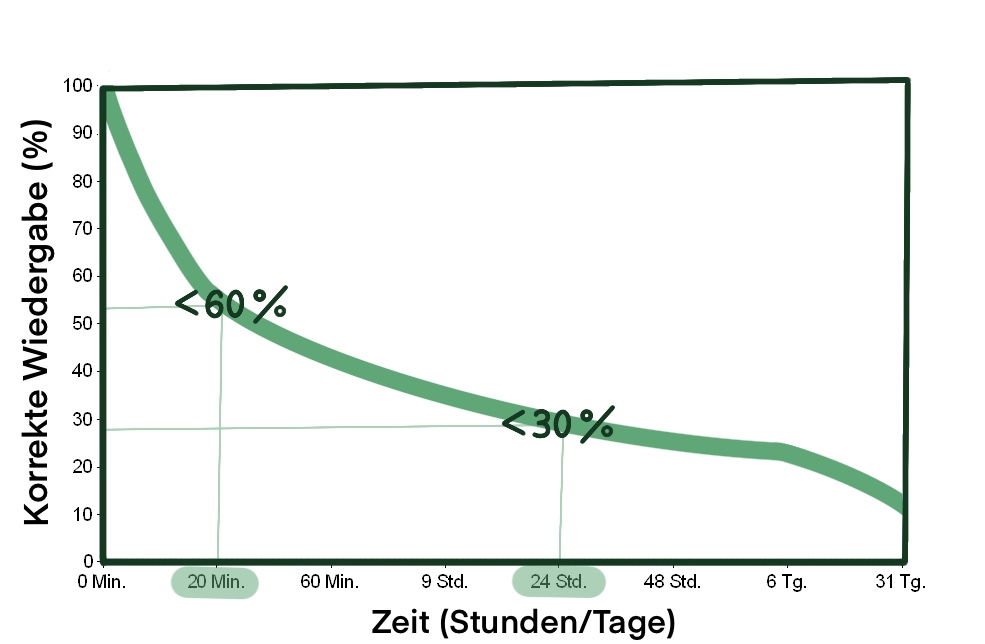Image credit: © Depositphotos.com/Dmyrto_Z
Perhaps you’ve experienced this: you learn new vocabulary and grammar structures, but only a fraction of it sticks in your long-term memory. Some things are gone by the very next day. This is actually quite normal and can be prevented with a few clever tricks and learning methods. Our recommendation: use spaced repetition systems in language learning! Find out exactly how it all works right here.
Table of Contents
Spaced Repetition – What Is It, Exactly?
Spaced repetition systems, often abbreviated as “SRS”, is a method for language learning designed to make the process as brain-friendly as possible, primarily targeting your long-term memory. As incredible as it sounds, we typically forget two-thirds of newly learned information after just one day.

‒ Language Course Discounts ‒
Find the best discounts and exclusive coupons for top
language courses here!
+ + + Limited-Time Deals +++ Some Offers Expiring Soon +++ Don’t Miss Out! + + +
This is precisely where an SRS comes in. What you’ve learned is methodically reviewed at specific, gradually increasing intervals until it finally lands in your long-term memory, ready to be recalled at any time. Forgetting is a thing of the past!
The Ebbinghaus Forgetting Curve
The foundation for spaced repetition systems in language learning and the related research is the Ebbinghaus forgetting curve, which illustrates the approximate time it takes for us to forget new information. And the results are shocking!
Hermann Ebbinghaus was a German psychologist renowned for his experimental research on memory. His key finding, discovered through targeted self-experiments and studies with others, was that on average, a staggering 40% of learned material is no longer retrievable just 20 minutes after a learning session. This number continues to drop dramatically within the first week. Ultimately, we only retain about 15% of what we’ve learned in our long-term memory—a remarkably small amount.

While these numbers can vary depending on the individual, the learning material, and other external factors, one thing is certain: we don’t retain nearly everything we learn. But this can be easily changed with methodical approaches. This is exactly where spaced repetition systems in language learning come into play. By using an SRS, everything we struggle to keep in our long-term memory is reviewed at regular intervals—until it can be recalled instantly, even long after we first learned it.
Using Spaced Repetition Systems in Language Learning
Now we know how quickly new knowledge is forgotten—but how can we counteract this? The trick lies in prevention, meaning not letting yourself forget the material in the first place. And that’s exactly what an SRS is designed to do!
Since we forget a lot of new information within 20 minutes after just a single review, it makes sense to internalize vocabulary and learning content multiple times within this timeframe. Ideally, this should involve a variety of learning and exercise formats to create different connections in the brain.

‒ The Best Language Course of 2025 ‒
We’ve tested dozens of language courses…
But only ONE takes the #1 spot!
Furthermore, you need to combat forgetting within the first 24 hours: daily learning is a must, and two shorter sessions can also be very effective. These could take place, for example, in the morning after waking up and in the evening before going to sleep, but of course, at any other time that works for you: on the train, while food is in the oven, during your lunch break, or wherever it fits best. The most important thing is establishing a routine and regularly engaging with the learning material.
When we review information just before the impending “point of forgetting,” we can counteract this curve. Every repetition solidifies new knowledge—but for the most brain-friendly results, it’s crucial to review within the right timeframe.
Learning Languages with SRS – The Best Providers
Of course, you could take this knowledge and create your own learning plan and try to implement it daily—but you don’t have to. Nowadays, several language course providers have recognized the importance of spaced repetition systems in language learning and have integrated them into their course structures.

‒ Language Course Discounts ‒
Find the best discounts and exclusive coupons for top
language courses here!
+ + + Limited-Time Deals +++ Some Offers Expiring Soon +++ Don’t Miss Out! + + +
This not only saves you the tedious task of creating a plan, but many apps also remind users to study daily and provide an extra dose of motivation with various gamification features.
MosaLingua: The Vocabulary Trainer with Built-in SRS
If you’re not looking for a full language course but rather a focus on vocabulary learning, MosaLingua is the perfect choice. Here, you learn a new language with audio flashcards and various exercises. And all of this is based on SRS, so your brain can absorb new information in the most sustainable way. The word selection is thoughtfully designed, teaching the most important, most frequently used 20% of the target language first.
The app is also actively developed, with new features and languages being added regularly—MosaLingua is definitely worth a look. The pricing is also very fair, and there’s a free trial version and lots of additional content freely available online. We love it and it is our top-recommendation when it comes to spaced repetition.
Babbel: The Classic Language Course
Babbel has long been one of the biggest names in language courses, and for good reason: its classic learning concept combines vocabulary and grammar lessons, similar to school. The advantage, however, is that Babbel specifically uses spaced repetition systems in language learning, ensuring that with regular use of the app, what you’ve learned stays in your memory for the long term. Excellent!
Subscription prices start at €6.99 per month, and there’s a free trial option as well as a 30-day money-back guarantee. That’s very fair! If you have a comprehensive interest in language learning, you should also take a look at their lifetime offer: for a one-time payment of €299, you can get access to all 13 learning languages.
Conclusion – Spaced Repetition Systems in Language Learning
Rote memorization is out, brain-friendly learning methods are in! And alongside approaches like the Birkenbihl method or Rosetta Stone’s Dynamic Immersion, this also includes SRS. This method ensures learning content is reviewed at targeted intervals before it’s forgotten, allowing vocabulary and grammar structures to remain in your memory for the long term.
Many language course providers have now understood this and have integrated it into their courses in various ways, so users don’t have to worry about finding the right rhythm themselves. If you’re looking for the best language course incorporation spaced repetition, you’ll find it imho with MosaLingua.
Either way, using spaced repetition systems in language learning provides added value and can be integrated into your individual study plan, either through a ready-made language course or as a standalone supplement.

Pingback: Busuu Costs Explained: What You Really Pay in 2025
thanks for info.
You are welcome 🙂